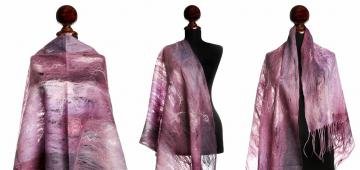 |
Nune Chukhajyan
At present, felting is widespread in Armenia. Nune Chukhajyan is doing art work in this type of craft. Works with various methods, such as nuno felting, felt drawing, and ecoprinting. She makes jackets, scarves, bags, hats and accessories.
|
|
|
New Reality and the Vision of Education Reform
There are numerous problems in the field of education, ranging from corruption to the necessity of introducing new educational programs, with the adjustment of educational objectives in general, which require immediate solutions. Are those in charge of sector reforms and the system itself ready for reforms? How can and should education change in Armenia?
Hayk Hambardzumyan discussed those issues with education expert Serob Khachatryan.
|
 |
Nare Bejanyan
Nare Bejanyan is an alpinist, she returned to Armenia from Doni Rostov. She confesses that it’s not easy to live in Armenia; she is often distressed. When she is ready to go back, the mountains come to help…
|
 |
Cultural Policy and the Public
After the revolution, we live in open and transparent times. Everyone has the opportunity to express their thoughts, whether good and bad, meaningful and not so. How does the culture feel itself in this great noise under the headlights?
Architect Misak Khostikyan and composer Vache Sharafyan are discussing the topic of cultural policy and public.
The conversation is hosted by Anna Sargsyan.
|
 |
Cultural Revolution
The vicious phenomena distorting public life, although often seem to be linked only to political, legal, or economic circumstances, however, for intellectuals, for people closer to the art, it is evident that it is the cultural crisis behind everything, which is expressed, for example, by the disrupted communication with art, indifference to literature, decline of reading, clarification of perceptions, concepts and values.
Is a cultural revolution possible? And is it necessary at all?
Hayk Hambardzumyan discussed these issues with poet and translator Hakob Movses.
|
 |
Matenadaran and the New Reality
Positive changes are taking place in Armenia. The society expects positive developments in cultural and scientific-educational spheres in parallel with the political, legal spheres. Particularly in the scientific system corruption, favoritism and politicism should be excluded, new models of effective management and financing of scientific institutions should be elaborated.
Are the scientific organizations ready for such changes and how did the scientific world react to the revolution? What new publications and programs are there in Armenian Studies?
Hayk Hambardzumyan talked about these issues with Doctor of Historical Sciences, Scientific Research Director of Matendaran Karen Matevosyan.
|
 |
Mamikon Mikayelyan, Ashot Mikayelyan
Mamikon and Ashot Mikayelyans are artists, sculptors and fond of experiments. They work with diverse materials: copper, silver, stone, wood. They even treat jewelry like a sculpture. The twin brothers work together, discuss, argue, agree, eventually producing such works which satisfy them both.
|
 |
The Revolution and Artsakh
After the velvel revolution, the attitude towards the issue of Artsakh changed: the issue of having Artsakh back to the negotiations table as full party of the conflict reveived emotional reflection.
The relations of RA-NK as two sovereign states obtain new accents. The wave of revolution got to Artsakh as well. What are the motives of these processes? The topic is discussed by Editor-in-Chief of Analyticon magazine Gegham Baghdasaryan and the Director of the Armenian Center for Strategic and National Research Manvel Sargsyan.
The topic is discusses by ethnologist Satenik Mkrtchyan and Communication Coordinator at Transparency International Anti-Corruption Center Haykak Arshamyan.
The conversation is hosted by Anna Sargsyan.
|
 |
Armenian Church and the “New” Nation
The more harmonized and regular the national bodies work, the more viable is the nation as an organism. What are our national institutes, what specific features do they have? In which case can we have a consolidated society, when under the disguise of the wave of most recent velvet revolution now an attempt is made to change the situation in the Armenian Church, and not in the system of public administration, and moreover, using the same methods of street demonstrations.
The topic is discussed by historian Vahe Torosyan and independent analyst Hayk Balanyan.
The conversation is hosted by Anna Sargsyan.
|
|
|
Anti-Canonical Issues, Church Reformations
The Mother See of Holy Etchmiadzin announced that it had decided to apply to Catholicos of all Armenians on initiating examination of Koryun Arakelyan's anti-canonical and anti-church actions with the Disciplinary Committee of the Mother See of Holy Etchmiadzin. The church council has clarified that obstructing the liturgy and disrupting the prayer atmosphere in the church hurts the spiritual feelings of many believers. The debate on the pavilion of "Option" refers to the moral and ethical issues that have emerged as a result of recent protests.
|
 |
New Education Environment: Precondition and Issues
Implementation of education reform is conditioned by the adjustment of educational objectives, the change of public attitude towards learning and development of enabling legislative framework. How and in what time frames can these conditions be met and who can implement these changes?
Hayk Hambardzumyan discussed those issues with education expert Serob Khachatryan.
|
 |
Life in the First Republic: Politics, Culture, Everyday Life
What was life like in the First Armenian Republic, how did people live, what films and performances they watched, was art developing, and what kind of writers were there? What were the relations of parties, church-state relations? The answers to these questions are hard to find in the history textbooks.
Hayk Hambardzumyan talked to historian Hamo Sukiasyan about the culture, lifestyle and politics of the First Republic.
|

